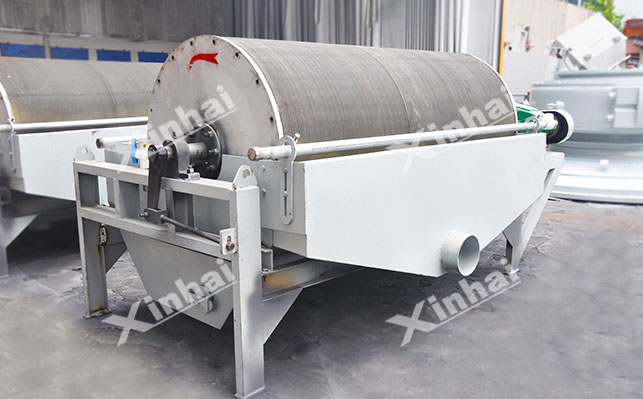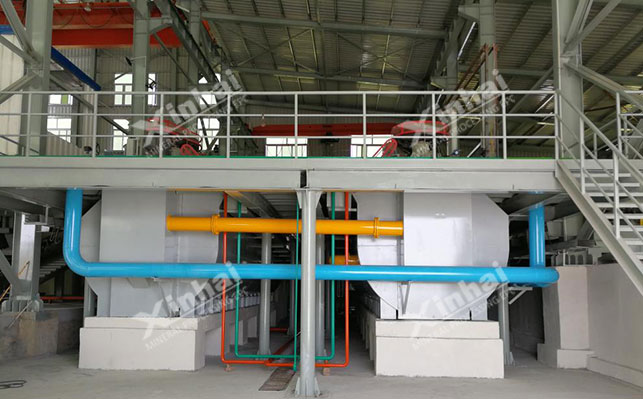
15311826613
Click to add WeChatIn the modern industrial system, fluorite ore, rich in calcium fluoride, is hailed as the "second-generation rare earth" and is an indispensable strategic resource in fields such as metallurgy, chemical engineering, and building materials. From steelmaking fluxing to fluorine chemical raw materials, from optical glass manufacturing to new energy material production, the application value of fluorite ore runs through the entire industrial chain. However, fluorite deposits in nature often coexist with gangue minerals such as quartz, calcite and dolomite, and effective separation needs to be achieved through scientific beneficiation methods. This article will introduce of the fluorite ore beneficiation methods from different perspectives.

Generally, the density of fluorite is 3.18g/cm³, while that of gangvein minerals such as fluorite is 2.65g/cm³. There is a density difference between the two, so gravity separation can be used to complete the beneficiation. It is often suitable for processing fluorite ore with coarse-grained interpolation. The gravity separation methods used include jigging gravity separation, shaker gravity separation and chute gravity separation. Among them, the jigging machine is suitable for processing fluorite ore with a particle size of 3-20mm, and the shaker is suitable for processing fluorite ore with a particle size of 0.5-3mm. Spiral chutes are suitable for processing fine-grained fluorite ore smaller than 0.1mm. However, the overall recovery rate of resected fluorite is usually within the range of 60% to 70%, and it is often used as a pretreatment step in the combined process.

Flotation is a process of separation based on the differences in the properties of mineral surfaces. Through the introduction of reagents and through processes such as rough selection, fine selection and sweeping selection, high-grade fluorite ore is obtained. Commonly used agents include oleic acid, oxidized paraffin soap and other collectors that do not collect fluorite. Inhibitors are selected based on the type of ore, such as sodium silicate to inhibit quartz, carboxymethyl cellulose to inhibit calcite, and sodium hexametaphosphate to disperse slime. Flotation is mostly suitable for treating fine-grained filled fluorite ores and low-grade fluorite ores.
When fluorite ore is accompanied by magnetic minerals such as magnetite and hematite, magnetic separation can be used for beneficiation. High-gradient magnetic separation is commonly used. By generating a strong magnetic field of 1-5T, magnetic impurities are captured, reducing the Fe₂O₃ content in fluorite from 0.3% to 0.05%, which meets the requirements of optical glass production. Magnetic separation is often used as an auxiliary process in flotation to further improve the quality of concentrate.

Chemical beneficiation is suitable for high-impurity and difficult-to-beneficiate ores. Impurities are dissolved through acid leaching (hydrochloric acid, sulfuric acid) or alkali leaching (sodium hydroxide).
Ore type | Key characteristics | Optimal process combination | Improvement of typical indicators | Applicable scenarios |
| Single-type fluorite ore | The grade of the raw ore is generally ≥85%, with low impurity content. The main component is CaF₂. The mineral crystal particle size is relatively coarse, and obvious fluorite crystal particles can be seen with the naked eye. | 1. Manual selection: Remove gangue minerals through manual or photoelectric sorting equipment; | Raw ore grade 85%→ concentrate grade 95%, recovery rate ≥90%, suitable for direct application in "high-precision and sophisticated" glass, optical materials and other fields. | The process is simple and the cost is low, making it suitable for open-pit mines or small mines with high grade. |
| 2. Gravity separation: By taking advantage of the density difference between fluorite and gangue, a shaker or jigging machine is used for further enrichment. | ||||
| Quartz fluorite ore | Fluorite and quartz are interwoven in fine particles (particle size <0.1mm), and the quartz content can reach 60%-80%. It is difficult to achieve effective separation through conventional mineral processing. | 1. Re-selection and pre-throwing tail: Use spiral chutes or hydrocyclones to remove some low-density quartz. | The raw ore grade is reduced from 18% to 72%, with a recovery rate of 75%-80%, effectively reducing the impact of quartz on subsequent processes. | It is suitable for complex ores with high quartz content and can significantly reduce the dosage of flotation reagents. |
| 2. Flotation: Sodium silicate is used as a quartz inhibitor, and fatty acid collectors are employed to enhance the flotation of fluorite. | ||||
| Calcare-type fluorite ore | Calcite (CaCO₃) and fluorite (CaF₂) have similar crystal structures and similar floatability, making flotation separation difficult and prone to the "co-flotation" phenomenon. | Flotation: Carboxymethyl cellulose (CMC) selectively inhibits calcite, combined with oleic acid collectors to achieve preferential flotation of fluorite. If necessary, reverse flotation is adopted for further purification. | The raw ore grade is reduced from 22% to 70% of the concentrate grade, and the CaCO₃ content is dropped below 3%, meeting the demand for metallurgical grade fluorite. | It is necessary to accurately control the chemical agent system, which is applicable to medium and low-grade ores with a relatively high calcite content. |
| Dolomite-type fluorite ore | Fluorite is wrapped by fine particles of dolomite (CaMg(CO₃)₂), which is prone to mudization during the grinding process and affects the flotation selectivity. Moreover, magnesium ions are prone to activate the surface of fluorite, resulting in an increase in the consumption of the reagent. | 1. Staged grinding: The "grinding - classification - re-grinding" process is adopted to avoid over-grinding; | The raw ore grade is 15%→ the concentrate grade is 68%, and the MgO content is controlled within 1%. It is suitable for industrial fields such as ceramics and cement. | It is necessary to be equipped with a classification device, which is suitable for processing ores with fine particle size distribution and easy to muddle. |
| 2. Reverse flotation: Oleic acid is used as the collector, tannin inhibits fluorite, and dolomite impurities are preferentially removed. | ||||
| Sulfide-type fluorite ore | It is often accompanied by sulfides such as pyrite and sphalerite. The ions Fe³⁺ and Zn²⁺ produced after the oxidation of sulfides will interfere with the flotation of fluorite, and the excessive sulfur content will affect the product quality. | 1. Priority flotation of sulfides: Remove sulfide ores with xanthate-based collectors; | The grade of raw ore is reduced from 12% to 75% of the concentrate grade, and the sulfur content is dropped below 0.1%, meeting the standard of chemical-grade fluorite. | Attention should be paid to the oxidation degree of sulfides, which is applicable to complex fluorite deposits associated with multiple metals. |
| 2. Fluorite flotation: Fluorite is carefully selected by using fatty acid collectors and sodium silicate regulators. |
Xinhai Case: The 400tpd fluorite ore beneficiation project in Mongolia. The raw ore minerals of this project contain 42.10% CaF2 and 43.43% SiO2. The gangue minerals are mainly quartz, sericite and dolomite. Among them, fluorite and quartz minerals coexist closely, and the particle size of the intercalation is relatively fine. Through beneficiation tests and analysis, Xinhai Mining Equipment finally designed a process for it: grinding - first roughing, first sweeping, flotation - re-grinding of coarse and concentrate - seven rounds of fine flotation. Process: Fluorite raw ore is ground to -200 mesh with a fineness of 70.6%. After one coarse and one clean flotation operation, the obtained coarse concentrate is reground to a fineness of -200 mesh with a fineness of 95%. It then enters seven fine selection operations. Finally, the yield of refined ore is 39.11%, the grade of CaF2 is 97.88%, and the recovery rate of CaF2 is 90.81%. The grade of SiO2 in the concentrate is 1.07%.